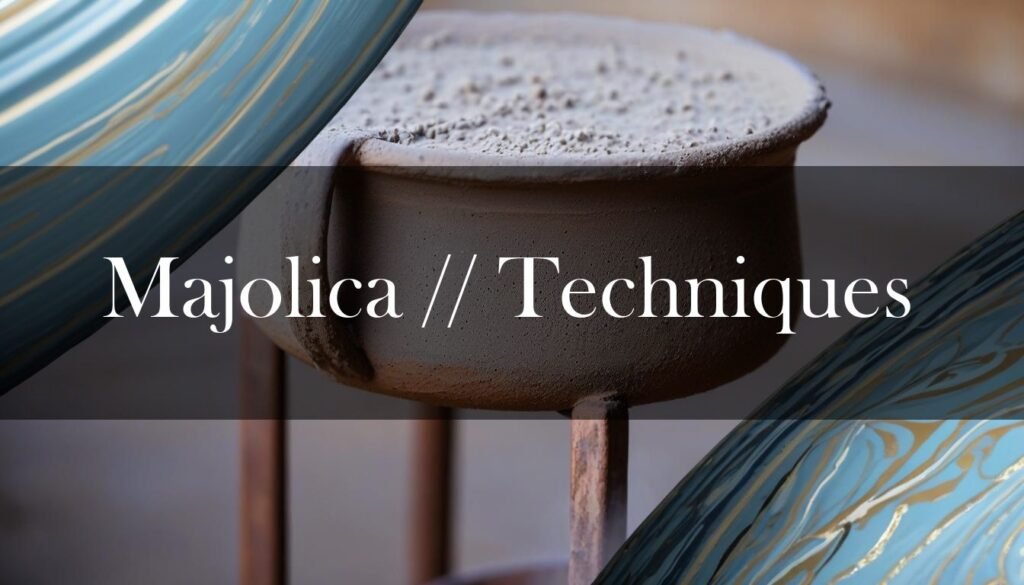Majolica, with its vibrant colors and intricate designs, boasts a rich history that continues to inspire ceramic artists today. The story of Majolica begins in the Islamic world, where artisans first developed the technique of tin-glazing to create opaque, white surfaces perfect for colorful decoration. This innovation then made its way to Spain via the Moors, leading to the creation of Hispano-Moresque ware. By the 14th century, cities like Málaga and Valencia were exporting these beautiful ceramics throughout Europe. The term “*Majolica*” itself is thought to come from “*Maiorica,*” the medieval Italian name for the island of Majorca, a key trading point for these ceramics.
During the Italian Renaissance, Italian artisans embraced and refined tin-glazing, giving rise to what we know as “*maiolica*.” Cities like Faenza, Urbino, and Deruta became famous for these ceramics, often decorated with historical and mythological scenes. However, the mid-19th century brought a resurgence of interest, particularly in England. The Minton Company introduced a new type of lead-glazed earthenware at the Great Exhibition in London in 1851. This “*majolica*” was brightly colored, hard-wearing, and inexpensive. Unlike the earlier tin-glazed version, this Victorian majolica involved applying colored lead silicate glazes directly to the ceramic body. By the early 20th century, majolica’s popularity declined, but the 1970s saw a revival of interest, especially among collectors. Exploring European Majolica: History, Design, and Influence can provide more information about this historical pottery tradition.
Creating Majolica pottery requires a few essential tools and equipment. The base is traditionally made using red earthenware clay.
Traditionally, the Majolica process involved completely coating terra cotta clay, or red-ware in an opaque white glaze.
Of course, you’ll also need a pottery wheel for shaping your forms. When it comes to glazing, a white base glaze is crucial.
Glaze each tile with 2-3 even coats of TC-11 White glaze (allow glaze to dry between coats)
To add your designs, underglaze colors, pencils, and high-quality brushes are essential.
Use good quality bamboo or watercolor brushes. Brushes should bounce, hold pigment well, and deliver a continuous stream of color to the glaze surface.
You can also check out Unlocking Majolica Techniques: History and Modern Inspiration to learn more about the tools and equipment required.
Don’t forget a banding wheel for smooth glaze application. And lastly, a reliable kiln is necessary for firing your Majolica pieces.
When it comes to design, Majolica pottery features a diverse range of motifs, patterns, and imagery. These reflect the cultural and artistic influences of their times. Common patterns include the “*Fan*” motif, particularly popular in Victorian-era Majolica. Another recurring theme is “*Ribbon and Leaf*,” with variations like “*ribbon and daisy*” and “*shell and net*.” Animal imagery is also frequent, including umbrella stands featuring goats, hares, ducks, and cranes, or fruit dishes adorned with foxes and rabbits. Floral and botanical themes, such as pansies, fuchsias, and ferns, are also quite popular.
The color palette of Majolica pottery is vibrant and varied, achieved using natural oxides and stains over a white tin glaze. Primary colors included cobalt blue, antimony yellow, iron red, copper green, and manganese purple. The pottery also features detailed imagery, especially in the “*istoriato*” style, depicting historical and mythical scenes.
Key colors to achieve the iconic Majolica look:
- Cobalt Blue
- Antimony Yellow
- Iron Red
- Copper Green
- Manganese Purple
Common Majolica Patterns:
- Fan
- Ribbon and Leaf
- Ribbon and Daisy
- Shell and Net
Today, Majolica continues to inspire contemporary ceramics through its rich history and vibrant aesthetics. Lisa Katzenstein integrates the vibrancy of Majolica in her work, making use of its qualities of translucent color. David Gamble explores a “*maiolica-like*” technique to create painterly surfaces on low-fire clay bodies.
In Mexico, artists such as Juan Soriano and Francisco Toledo collaborated with artisans to revitalize Majolica traditions, creating innovative designs that breathe new life into the craft. Rebecca Graves integrates illustration with ceramics through Majolica techniques, expressing personal narratives and artistic visions.





